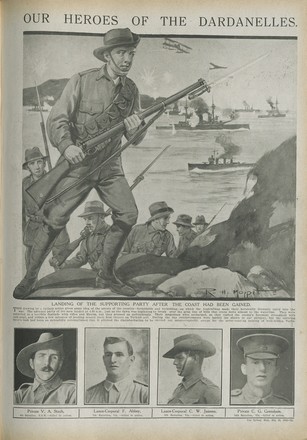Bartlett’s reports
were well received back in Australia, particularly as they were written by a
British observer.
This bird’s eye
view shows major topographical features with heights and distances; positions of
landings, front lines, forts, batteries and townships.
Of the Anzacs, Bartlett
wrote: ‘They waited neither for orders nor for the boats to reach the beach,
but, springing out into the sea, they waded ashore, and, forming some sort of
rough line, rushed straight on the flashes of the enemy’s rifles.’
The Graphic map details the various Allied
landings, including those of the Australian and New Zealand troops, along with
locations where French and British troops landed throughout the campaign.
Ashmead-Bartlett
served as the Conservative Member of Parliament for North Hammersmith in London
between 1924 and 1926.
The ANZAC map
of Gallipoli illustrates the maze of trenches which had been dug into the
hillsides at Gallipoli and shows how close the opposing trenches were at
certain points. Captain Aubrey Wiltshire observed in his diary at Gallipoli; ‘Turkish
trenches running parallel to our line right along. Absolutely no one in sight
and yet beneath the parapet they are in their thousands. Our trenches are a
network of deep trenches as confused as the catacombs of Rome surely. The
support trenches have recesses cut in them for sleeping purposes where men
rest. The fire trench is full of observers and others specially armed and
always on the alert.’
Ashmead-Bartlett
continued to write about the Gallipoli campaign, publishing The Uncensored Dardanelles in 1928.
Ellis
Ashmead-Bartlett was a seasoned war correspondent who had covered a number of
skirmishes for the British press.
Allied troops remained
on the Gallipoli Peninsular until 19-20 December 1915. This campaign cost
Australia 26,111 casualties, including 8,141 deaths.
Bartlett sailed
to Gallipoli with the Australian troops who formed the covering party for the
landing on 25 April. He went ashore 24 hours later. Unlike official war
correspondent, Charles Bean, who lived with the troops on the peninsular, Bartlett
was based at the official press camp on the island of Imbros.



 Back to list
Back to list